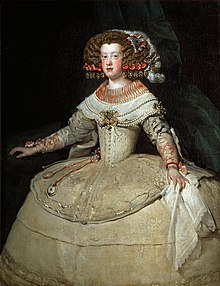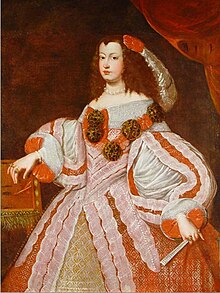File talk:Infanta Maria Teresa (1638-1683, future Queen of France) by Juan Carreño de Miranda.jpg
Jump to navigation
Jump to search
Change of identity[edit]

This girl is plainly not the Infanta Margarita. It is her older sister Maria Teresa who became Queen of France.
- The website that the file was taken from is a firm of restorers, not an art gallery, or other reliable source.
- Infanta Margarita's face is very well known. She is the child at the centre of Velazquez's famous "Maids of Honour". She had blonde waving hair, which was not very thick. It did not grow from a "widow's peak" on her forehead. Even in the earliest pictures, there is sign of the Hapsburg overbiting lower jaw.
- She grew into a thin pale, blonde-haired young woman with rather protruberant eyes and a very marked overbite.
- Maria Teresa, on the other hand, is depicted several times (though not as famously) by Velazquez. She has a plumper face without the pronounced jaw, with a high colour in her complexion and very thick, very curly brown hair, which grows from a very marked peak on her forehead.
It is obvious that the restorers or owners of the work have got the identity wrong.
Amandajm (talk) 00:31, 19 November 2010 (UTC)
The dates of the caption are still those of Margareta Teresa and should be changed to those of Maria Teresa, 1638-1683, to avoid confusion.



- (to Achim and others (?)):
- I agree fully, that this cannot be Margarita Teresa. But the identification with Maria Teresa is doubtful, too.
- Maria Teresa might have been a bit "plumper...", but she was blonde (all french portraitists painted her blonde, Velázquez a bit darker but blonde too; but at the spanish court in 1650-1660 she wore probably a wig, because of the very artificial hairstyle) and she had blue eyes . The woman here has dark brown eyes, brown hair and a quite beautiful face and she seems to be quite sure of herself, Maria Teresa was not at all beautiful and her character of a certain timidity and modesty.
- And there are other problems: Maria Teresa lived in Spain only until summer 1660, when she went for ever to France to marry Louis XIV.. At that time Velázquez was the court painter (he died 1660 some weeks after the marriage).
- Juan Carreño de Miranda worked for the first time 1659 for the royal family in the Royal Palace (Alcácer) in the hall of mirrors, but as a painter of frescos. He became royal painter in 1669 and court painter in 1671. When should he have portrayed Maria Teresa ?
- The hair- and dress-style don't correspond to the style at the royal Court of Spain until 1660, but is clearly later. (And it doesn't correspond to french (=european) hair- and dress-styles of 1650-1680, too.)
- Unfortunately, I don't have one of the very rare books about Juan Carreño de Miranda, but I think, one should change the title into "Portrait of a Lady by Juan Carreño de Miranda".
- Greetings, --Marie Adelaide (talk) 15:51, 10 August 2018 (UTC)
- Ping Shakko. --sasha (krassotkin) 22:08, 11 August 2018 (UTC)